Households - statistics on income, saving and investment
Data extracted in November 2023.
Planned update: November 2024.
Highlights
Wages accounted for 36.6 % of the EU's household disposable income in 2022, and social benefits for 24.8 %.
In 2022, the household saving rate was 12.7 % in the EU and 13.7 % in the euro area.
The EU's household investment rate was 10.0 % in 2022. The highest rates among the Member States were 15.2 % in Cyprus and 13.9 % in Luxembourg.
Gross household saving rate, 2012–2022
This article focuses on disposable income, saving and investment for households in the European Union (EU) and the euro area; note that there are complementary articles that provide information on financial assets and liabilities for households, for financial assets and liabilities of non-financial corporations and the distribution of profits and investment for non-financial corporations.
This article presents Eurostat statistics derived from European sector accounts, which form part of the European system of national and regional accounts (ESA 2010). Data are provided for the EU and the euro area, as well as for individual EU Member States, EFTA countries, Serbia and Türkiye for the latest reference year available and for developments over the previous 10 years.
The time period covered by the analyses in this article is 2012 to 2022. When looking at developments during this period, it should be remembered that the global financial and economic crisis had a major impact on economies and societies in the EU. As such, the starting point for the time series that are presented is a year (2012) with a relatively low level of economic activity, in real terms still 1.1 % below the 2008 pre-crisis peak. The time series ends in 2022, which was the third year of the COVID-19 pandemic, which also had a major impact on economies and societies. Furthermore, the final year in the period under consideration was also during the current period of relatively high price increases (the cost-of-living crisis). The annual inflation rate in the EU was 9.2 % in 2022, far higher than in any other year since the time series began in 2001; the next highest rate was 3.7 % in 2008.
Full article
General overview
This article provides a range of analyses of issues that impact on people's everyday lives, detailing levels of gross household adjusted disposable income that is available for households to manage their budget. Overall household spending and/or saving are closely linked to general macroeconomic developments, including among other factors, real wage growth, inflation and the risk of unemployment. Note that data presented in this article cover both the household sector and non-profit institutions serving households (NPISH); the latter form a relatively small institutional sector that includes charities, trade unions, religious and political groups.
Gross disposable income is the result of all current transactions before consumption, excluding exceptional resources/uses such as capital transfers, holding gains/losses and the consequences of natural disasters. It reflects the net resources, earned during the period, which are available for consumption and/or saving; in this article – unless otherwise stated – it is adjusted to take account of social transfers in kind. Adjusted gross disposable income includes the flows corresponding to the use of individual services which households receive free of charge from the government; these mainly include education, health and social security services, as well as housing, cultural or recreational services.
Gross household adjusted disposable income
The EU's gross household adjusted disposable income was valued at €11 586 billion in 2022, which was equivalent to three quarters (73.3 %) of the value of gross domestic product (GDP).
Germany accounted for the highest share of the EU's gross household adjusted disposable income, 25.5 % of the total, followed by France (18.3 %) and Italy (13.0 %).
Figure 1 shows information for gross household adjusted disposable income per inhabitant (taking into account population change due to natural change and migration) during the period 2003 to 2022. Gross household adjusted disposable income per inhabitant in the EU in nominal terms declined in 2009 as a result of the global financial and economic crisis: the real rate of change turned negative in 2010 and remained negative in 2011, 2012 and 2013 as the economic recovery was not sustained. Thereafter, there was an upturn in both the EU and the euro area, with gross household adjusted disposable income per inhabitant increasing in both nominal and real terms every year from 2014 to 2021. In 2020, the first year of the COVID-19 crisis, the real rates of change remained positive, although considerably lower than in the preceding few years, but rebounded in 2021 to record a peak for the period under consideration: up 2.9 % in the EU and up 2.6 % in the euro area. In 2022, the development was notably different: in nominal terms, higher increases were observed than in 2021, up 6.3 % in the EU and 5.7 % in the euro area, while in real terms the first negative rates since 2013 were observed, down 0.8 % in the EU and 0.9 % in the euro area.
A time series of gross household adjusted disposable income between 2012 and 2022 is provided in Table 1 of the annex; see the link later in this article.
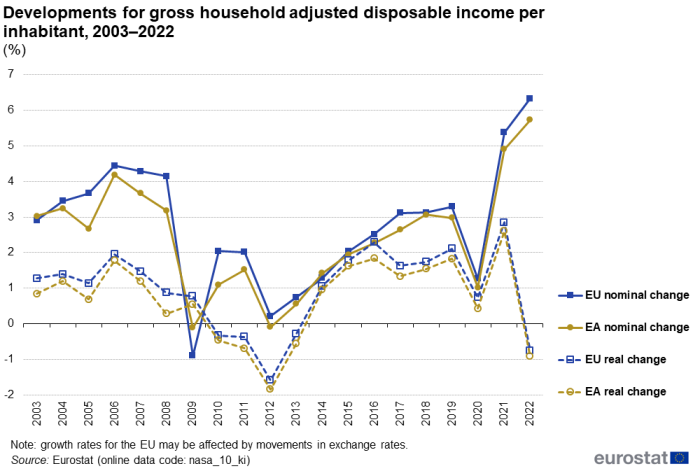
(%)
Source: Eurostat (nasa_10_ki)
Gross household adjusted disposable income per inhabitant in Luxembourg was 2.1 times as high as in Slovakia
To compare gross household adjusted disposable income per inhabitant across countries effectively, an adjustment should be made to take account of price level differences. To do so, data are converted into purchasing power standards (PPS). The information presented in Figure 2 is based on data in PPS, but with the values then converted to a ratio between the values for each EU Member State and the EU average; the ratio for the EU average is set to equal 100.
In 2022, the highest level of gross household adjusted disposable income per inhabitant was recorded in Luxembourg (43.5 % above the EU average having taken account of price level differences), while Germany (24.5 %) and Austria (21.0 %) were the only other EU Member States (no information available for Bulgaria, Malta or Romania) to report levels of gross household adjusted disposable income per inhabitant that were more than one fifth above the EU average; this was also the case for Switzerland.
By contrast, there were seven EU Member States where the average level of gross household adjusted disposable income per inhabitant was more than 20 % below the EU average. Among these, the lowest levels of gross household adjusted disposable income per inhabitant in 2022 were recorded in Latvia (69.8 %), Greece (67.7 %) and Slovakia (67.3 %).
Comparing the EU Member States with the highest and lowest ratios in 2022, the average level of gross household adjusted disposable income per inhabitant in Luxembourg was 2.1 times as high as that recorded in Slovakia (no data are available for Bulgaria, Malta or Romania). Note however that a similar comparison for 2012 – just 10 years earlier – reveals that gross household adjusted disposable income per inhabitant in Luxembourg had been 2.8 times as high as in Latvia (see Table 2 in the annex). For comparability, this ratio for 2012 was compiled for the same Member States for which 2022 data are available; if Bulgaria is included, for which 2012 data are available, the ratio between the highest (still Luxembourg) and lowest (Bulgaria) values was 3.5.
A time series of gross household adjusted disposable income per inhabitant between 2012 and 2022 is provided in Table 2 of the annex; see the link later in this article.
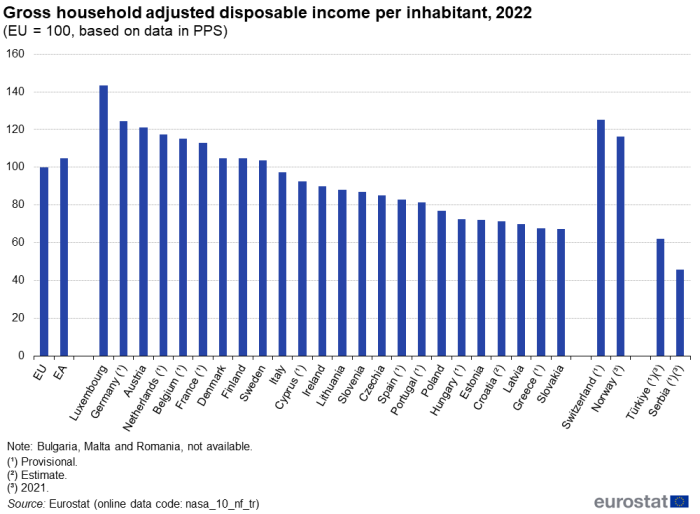
(EU = 100, based on data in PPS)
Source: Eurostat (nasa_10_nf_tr)
Having fallen to 35.8 % in 2020 (from a peak of 36.9 % in 2019), the share of net wages in the EU's gross household adjusted disposable income partially recovered to 36.2 % in 2021 and 36.6 % in 2022
Figure 3 provides an analysis over time of the different contributions that were made by the various components which together make up gross household adjusted disposable income. In the EU, net wages (which consist of wages and salaries received by employees before tax, excluding social contributions paid by employers and employees) consistently accounted for the highest share of gross household adjusted disposable income between 2012 and 2022. The share of net wages was just over one third (within the range of 34.5 % to 36.9 %). The relative share of net wages in gross household adjusted disposable income was at its lowest level, as may be expected, after the financial and economic crisis and subsequently increased to reach a peak in 2019. This share increased almost every year during the period shown, the only notable fall being in 2020, impacted by the COVID-19 crisis.
Mixed income of households relates to the profits of unincorporated enterprises and represents remuneration for work that is carried out by self-employed persons or members of their family; gross operating surplus accrues from renting out or owning a dwelling. As with net wages, the contribution from these components to EU gross household adjusted disposable income fell during the global financial and economic crisis. This share stabilised in a range of 20.2 % to 20.6 % between 2012 and 2018. For two years the share fell, down slightly to 19.9 % in 2019 and more rapidly to 19.3 % in 2020. The share from gross operating surplus and mixed income then stabilised at this lower level, with shares of 19.3 % and 19.4 % recorded in 2021 and 2022; the share in 2022 was 1.1 percentage points (pp) below the 2012 level.
The second largest contribution to EU gross household adjusted disposable income was from social benefits (other than social transfers in kind). These include the following: payments from social security funds (such as pensions or child support); social assistance from government or non-profit institutions serving households; privately funded social benefits such as those made by insurance companies. The share of social benefits in EU gross household adjusted disposable income rose from 24.9 % in 2012 to 25.3 % in 2013, 2014 and 2015. Thereafter, the contribution of social benefits to EU gross household adjusted disposable income fell back modestly and was 24.9 % in 2019. The impact of the COVID-19 crisis can again be seen, as this share rose to 26.8 % in 2020, the highest share for this component throughout the period studied. Subsequently, it dropped back somewhat to 25.8 % in 2021 and by 2022 had fallen to 24.8 %, almost the same share as observed 10 years earlier.
In the years following the global financial and economic crisis, the contribution of social transfers in kind to EU gross household adjusted disposable income drifted up from 17.4 % in 2012 to 17.8% in 2016 and then stayed around this level. Impacted by the COVID-19 crisis, the share rose from 17.7 % in 2019 to 18.3 % in 2020 and then climbed further to 18.7 % in 2021. It then fell back to 18.4 % in 2022, some 1.0 pp above the level 10 years earlier.
Unlike the other components which add to gross household adjusted disposable income, the level of disposable income is reduced by taxes paid; for this reason, taxes are shown as negative values in Figures 3 and 4. The negative share of EU gross household adjusted disposable income that was accounted for by taxes fell during the global financial and economic crisis. Thereafter it increased steadily, expanding from -14.1 % of income in 2012 to -14.9 % by 2019. In 2020, the negative share accounted for by taxes fell, reflecting the fall in net wages during the first year of the COVID-19 crisis. In 2021 and 2022, the negative share increased somewhat, reflecting the partial recovery of the share of net wages, reaching -14.6 % in 2022, some 0.5 pp more than in 2012.
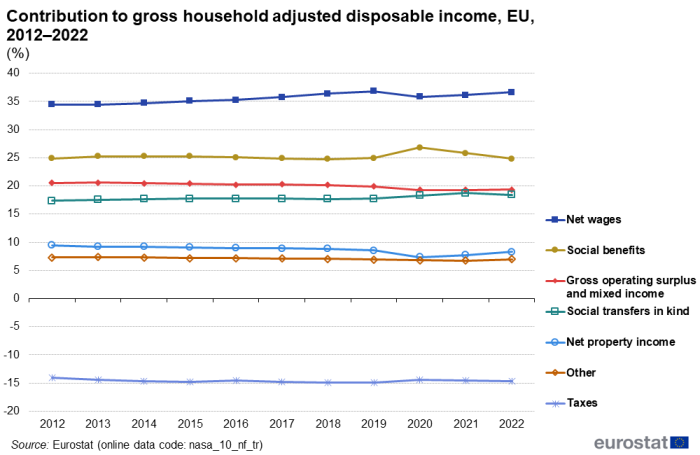
(%)
Source: Eurostat (nasa_10_nf_tr)
A similar analysis is presented in Figure 4 which details the contributions of the various components to gross household adjusted disposable income in 2022 for the EU Member States as well as in Norway, Switzerland and Serbia. Similar data in euro, rather than as a percentage of gross household adjusted disposable income, are provided in Table 3 of the annex; see the link later in this article.
Net wages and gross operating surplus and mixed income together accounted for 56.0 % of gross household disposable income in the EU in 2022, while the combined share of social benefits and social transfers in kind was 43.2 %. Looking in more detail at the individual EU Member States, there were considerable variations in terms of the contributions made by each component to gross household adjusted disposable income. In 2022, net wages and gross operating surplus and mixed income together accounted for 73.6 % of disposable income in Denmark, 72.1 % in Ireland, 66.9 % in Latvia and 66.2 % in Estonia. By contrast, this share was under half of the total in Germany (47.8 %). Net wages were valued 8.2 times as high as the gross operating surplus and mixed income in Sweden, 5.7 times as high in Denmark and 4.9 times as high in Estonia. By contrast, in Poland and most notably in Greece, the value of the gross operating surplus and mixed income was greater than the value of net wages.
With the exceptions of Hungary and Italy, the relative weight of social benefits in gross household adjusted disposable income in 2022 ranged from 17.9 % to 26.7 %. In Hungary (16.4 %) the share was somewhat lower, while in Italy it was higher (29.4 %); it was higher still in Switzerland (30.6 %).
Social transfers in kind accounted for 12.8 % of gross household adjusted disposable income in Portugal in 2022, the lowest share among the EU Member States; a slightly lower share was reported in Serbia (12.4 %; 2021 data) and a much lower one in Switzerland (9.5 %). Shares below the EU average were reported in all of the eastern, southern and Baltic Member States; in Germany and Austria the shares were equal to the EU average. Above average shares were observed in the remaining western and Nordic Member States, exceeding 25.0 % in the Netherlands, Denmark and Sweden.
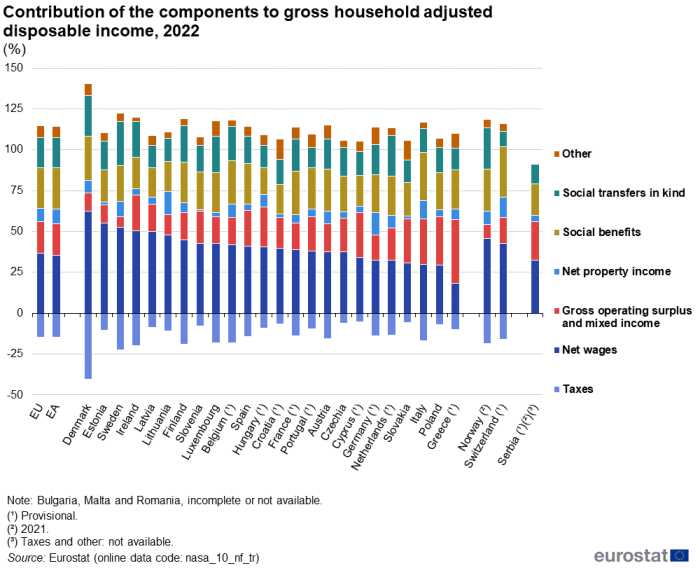
(%)
Source: Eurostat (nasa_10_nf_tr)
Figure 5 shows the contribution from a number of different components to the overall change in gross household adjusted disposable income between 2012 and 2022; note these changes are based on information in current prices. On this basis, EU gross household adjusted disposable income rose overall by 35.0 % during the most recent decade for which data are available. The largest contributions were made by net wages (contributing 15.0 pp of the overall change), social benefits (8.6 pp), social transfers in kind (7.5 pp) and gross operating surplus and mixed income (5.7 pp); taxes made the largest negative contribution (-5.7 pp).
In a majority of EU Member States (incomplete or no recent data for Bulgaria, Malta and Romania), the main contributing factor to the development of their gross household adjusted disposable income was net wages; this was also the case in Switzerland.
- In Italy, the main factor was the increase in gross social benefits.
- In Cyprus, the largest contributing factor was the change in the gross operating surplus and mixed income.
- In Greece, the largest factor was net property income; this was also the case in Norway (2012–2021).
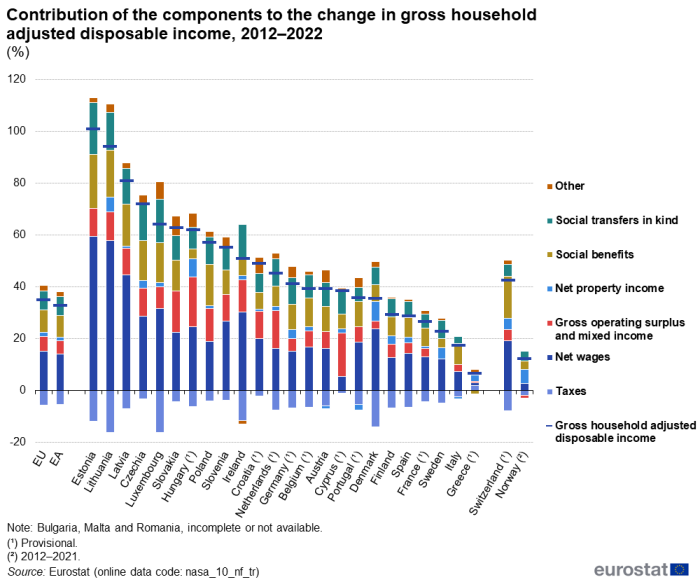
(%)
Source: Eurostat (nasa_10_nf_tr)
Household saving rate
During periods of economic uncertainty, household saving rates may be expected to increase, as households tend to save more when the risk of losing a job rises and they may defer expenditure on some or many non-essential goods and services (for example, the purchase of a new motor vehicle or a family holiday) until the economic situation improves. At the same time, saving rates could be also influenced by negative changes in disposable income, which would lead to lower savings rates. The household saving rate is defined as gross household saving divided by gross disposable income, with the latter being adjusted for changes in net equity of households in pension fund reserves.
Households in the EU saved close to one eighth of their disposable income
Figure 6 reveals that the EU household saving rate was 12.7 % in 2022, while the rate for the euro area was higher, at 13.7 %.
- In 2022, the highest gross saving rate among the EU Member States (no data available for Bulgaria, Malta or Romania) was recorded in Germany (19.9 %), followed by the Netherlands (19.4 %); a higher rate was observed for Switzerland (23.4 %), while Norway also recorded a comparatively high rate (19.4 %; 2021 data).
- There were 12 EU Member States which recorded saving rates below 10.0 % in 2022, among which Poland and Greece had negative rates, -0.8 % and -4.0 %, respectively. A negative saving rate indicates that households spent more than their gross household disposable income and are therefore either using accumulated savings from previous periods or are borrowing to finance their expenditure.
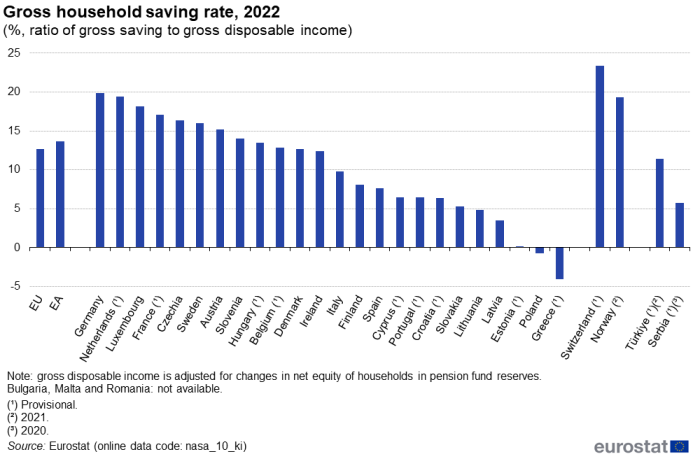
(%, ratio of gross saving to gross disposable income)
Source: Eurostat (nasa_10_ki)
Developments for household saving rates during the period 2012 to 2022 are presented in Figure 7. The EU saving rate was relatively stable between 11.6 % and 11.8 % from 2012 to 2018. It then increased to 12.3 % in 2019 before jumping to 18.5 % in 2020 and 16.4 % in 2021, as the COVID-19 crisis took hold. Savings increased during the COVID-19 crisis as some opportunities for consumption expenditure were restricted, for example concerning the purchase of hospitality, entertainment and travel services; this was particularly notable in 2020. In 2022, the EU saving rate returned close to its previous level, falling to 12.7 %.
Figure 7 also shows developments for the saving rates of the four largest EU economies. Throughout this period, the rates in Germany and France were above the EU average. By contrast, in Italy and Spain the rates were consistently below the EU average, with the rate in Spain lower than that in Italy except in 2020.
- During the period studied, the household saving rate in Germany was the highest among these four large economies and remained within the range of 16.7 % to 18.6 % until the sharp increase in 2020 brought it to 23.7 %; in 2021, it dropped back slightly to 22.7 % and in 2022 it fell to 19.9 %.
- The household saving rate in France was the second highest among the four large economies shown in Figure 7. It fell from 15.3 % in 2012 to 13.6 % in 2016 before increasing to 14.7 % by 2019; in 2020 it jumped to 20.5 % before dropping back to 18.6 % in 2021 and 17.1 % in 2022.
- The Italian household saving rate rose from 9.3 % in 2012 to 11.3 % by 2014. Thereafter, the rate declined to 10.0 % in 2019. A 7.4 pp increase in 2020 brought the Italian rate to 17.4 %, before falling to 15.5 % in 2021 and to 9.8 % in 2022, in other words just below its 2019 level.
- In Spain, the development was somewhat more volatile than in the other large EU economies, but with a relatively similar overall development. The household saving rate was 6.5 % in 2012 and ranged between 5.6 % and 8.2 % between 2013 and 2019. An increase of 9.3 pp was observed in 2020, more than doubling the rate to reach 17.5 %, marginally above the rate in Italy and the closest the rate in Spain had been to the EU average during the period studied. In 2021, the gross household saving rate in Spain fell back to 13.8 % and in 2022 it fell to 7.6 %, below its 2019 level.
Time series between 2012 and 2022 are provided for gross household saving in euro and the gross household saving rate in Tables 5 and 6 of the annex; see the link later in this article.
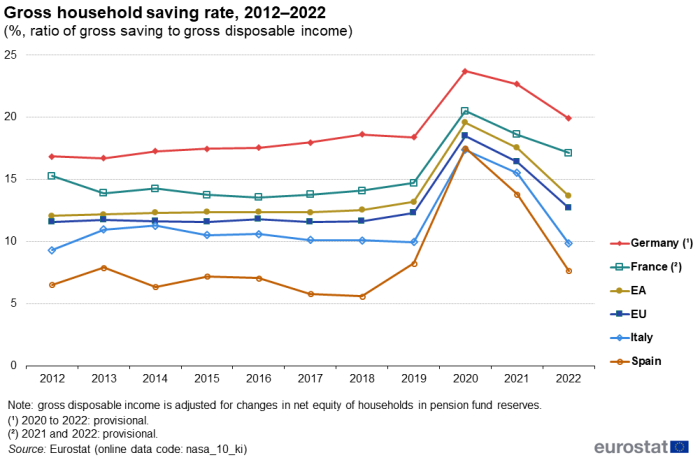
(%, ratio of gross saving to gross disposable income)
Source: Eurostat (nasa_10_ki)
The final analysis in this section divides the latest 10-year period into two parts. The first analyses changes in the household saving before the COVID-19 crisis. The second compares the rate just before the crisis with the latest year – see Figure 8. The EU household saving rate increased by 0.7 pp between 2012 and 2019 and was 0.4 pp higher in 2022 than in 2019. A larger increase was observed between 2012 and 2019 for the euro area's household saving rate (up 1.1 pp) accompanied by a slightly larger difference (0.5 pp) between 2019 and 2022.
Data are available for 24 EU Member States: the analysis is not available for Bulgaria, Malta and Romania.
- Czechia and Luxembourg (note that there is a break in series) observed a larger increase in their household saving rate between 2019 and 2022 than the increase between 2012 and 2019.
- Four Member States – Belgium, Ireland, France and Austria – observed an increase between 2019 and 2022 following on from a decline between 2012 and 2019.
- Portugal was the only Member State to record a decrease in its household savings rate in both periods; the decrease was smaller between 2019 and 2022 than in the earlier period.
- In the remaining Member States, the reverse situation was observed:
- Denmark, Germany, Cyprus, Lithuania, the Netherlands and Slovenia recorded smaller increases in their household saving rates between 2019 and 2022 than between 2012 and 2019;
- 11 Member States record a lower household saving rate in 2022 than in 2019 (a fall in the rate) having recorded an increase between 2012 and 2019.
Latvia recorded the largest overall increase in its household saving rate between 2012 and 2019, up 8.0 pp. The next highest increases were 5.9 pp in Estonia, 4.7 pp in Croatia and 4.6 pp in Hungary. There were five EU Member States where the household saving rate decreased between 2012 and 2019. The largest decreases were in Belgium (down 2.2 pp) and Portugal (down 2.6 pp).
For the more recent period, the largest increases in the household saving rate were in Luxembourg and Czechia, up 3.4 pp and 3.3 pp, respectively, between 2019 and 2022. Estonia recorded the largest decrease (down 11.8 pp).
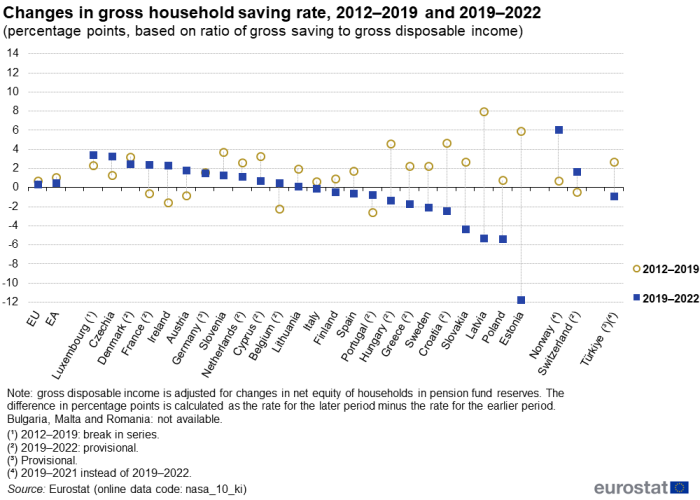
(percentage points, based on ratio of gross saving to gross disposable income)
Source: Eurostat (nasa_10_ki)
Household investment rate
Household investment mainly consists of the purchase and renovation of dwellings; expenditure on consumer durables (such as passenger cars) is not considered part of this component (and is included in final consumption) nor are financial investments. Note also that the investment statistics that are presented in this section also include investments made by unincorporated enterprises (principally sole proprietors). The household investment rate is defined as gross fixed capital formation (mainly dwellings) divided by gross disposable income, with the latter being adjusted for changes in net equity of households in pension fund reserves. Among other uses, this indicator provides a means of analysing the crash experienced in housing markets – linked to the subprime mortgage and credit crisis – during the global financial and economic crisis.
Household investment rates were 15.2 % in Cyprus and 13.9 % in Luxembourg in 2022
Across the EU, households invested 10.0 % of their gross household disposable income in 2022; this figure was slightly lower than the rate recorded in the euro area (10.3 %). Household investment rates in the EU Member States ranged from 15.2 % in Cyprus and 13.9 % in Luxembourg to 4.4 % in Latvia and 4.2 % in Greece.

(%, ratio of gross fixed capital formation to gross disposable income)
Source: Eurostat (nasa_10_ki)
Figure 10 shows the development of household investment rates between 2012 and 2022. In the EU, the impact of the aftermath of the global financial and economic crisis was still apparent, with the rate falling from 8.8 % in 2012 to 8.1 % in 2015. This development was reversed in 2016, with the rate increasing each year to reach 8.6 % by 2019. This upward development was interrupted in 2020 by a slight fall (to 8.5 %). Subsequently the rate jumped to 9.6 % in 2021 and to 10.0 % in 2022, both of which were higher than in any other year studied.
- In Italy, the household investment rate fell from being the close to the German and French rates in 2012 to a level below the EU average by 2014. From 2015 to 2019, the Italian rate was relatively stable, but fell in 2020 to 7.2 % before increasing strongly in 2021 to 10.4 % and in 2022 to 11.5 %; the 2022 value for Italy was the highest among the four largest EU economies.
- The German household investment rate remained in the range of 9.3 % to 9.8 % between 2012 and 2019. The rate then increased, reaching 11.0 % in 2022, which was the only year in which Germany did not have the highest rate among the four largest EU economies.
- In France, the household investment rate ranged from 8.9 % to 9.6 % between 2012 and 2020. It fell to the bottom of this range in 2020 and then jumped above it in 2021 (10.2 %) and increased again in 2022 (10.4 %).
- In Spain, the development was initially similar to that in Italy, but with a larger fall in the household investment rate, down from 6.5 % in 2012 to 4.6 % in 2015 and 2016. The rate increased thereafter, reaching 5.5 % in 2019, before dropping slightly to 5.4 % in 2020. In 2021 and 2022, the Spanish household investment rate increased to 6.6 % and 7.1 %, respectively. These two rates were higher than in any year during the period studied. For the whole of the period between 2012 and 2022, Spain had the lowest household investment rate among the four largest EU economies.
Time series between 2012 and 2022 of gross fixed capital formation in euro and of the gross household investment rate are provided in Tables 7 and 8 of the annex; see the link later in this article.

(%, ratio of gross fixed capital formation to gross disposable income)
Source: Eurostat (nasa_10_ki)
In many EU Member States, the global financial and economic crisis and/or the subsequent sovereign debt crisis had a strong impact on the household investment rate. Much of the impact was over before the beginning of the periods analysed in Figure 11 (2012–2017 and 2017–2022), although rates in some Member States were relatively low at the start of the period studied.
A comparison of changes for the household investment rate between the two periods covered in Figure 11 reveals that in 15 EU Member States investment rates were rising at a faster pace (or rising rather than falling) between 2017 and 2022 than had been the case between 2012 and 2017; note that no data are available for Bulgaria, Malta or Romania. The exceptions were the following:
- Latvia and Poland recorded smaller decreases between 2017 and 2022 than between 2012 and 2017 and were the only Member States that recorded a decrease in both periods;
- Sweden, Estonia, Luxembourg (note that there is a break in series), Lithuania, Ireland, Slovenia and the Netherlands each recorded a smaller increase between 2017 and 2022 than between 2012 and 2017.
Norway, Switzerland and Türkiye were also exceptions to this general pattern. In Norway and Türkiye, the household investment rate increased between 2012 and 2017 but decreased in the more recent period (both 2017–2021). In Switzerland, the decrease between 2012 and 2017 accelerated between 2017 and 2022.
Focusing just on the most recent change in the household investment rate (see Table 8 in the annex), the rate was 0.4 pp higher in the EU in 2022 than in 2021, continuing the increase observed the year before (up 1.1 pp). Between 2021 and 2022, the household investment rate increased in 17 of the 24 EU Member States for which data are available (no data for Bulgaria, Malta or Romania). Four Member States recorded increases in the gross household investment rate of more than 1.0 pp, with the largest increase in Ireland (up 1.9 pp). The largest decrease was in Czechia, down 1.0 pp.
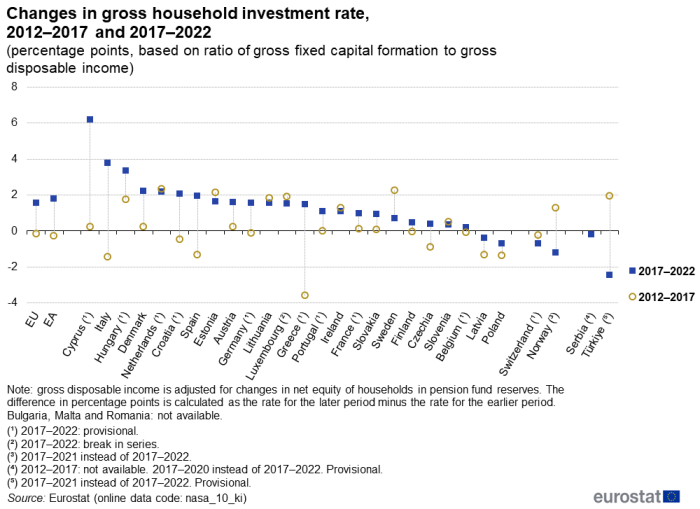
(percentage points, based on ratio of gross fixed capital formation to gross disposable income)
Source: Eurostat (nasa_10_ki)
Source data for tables and graphs
Data sources
The compilation of sector accounts follows the European system of accounts (ESA 2010). It provides the basis for all of the data for the EU Member States, EFTA countries and enlargement countries, as collected by the European Central Bank (ECB) and Eurostat. Together they publish integrated non-financial and financial accounts, including financial balance sheets, for the euro area; Eurostat also publishes the non-financial accounts of the EU.
The non-financial accounts
Non-financial accounts provide a systematic description of the different stages of the economic process: production, generation and distribution, use and accumulation of income. Each of the accounts ends with a balancing item: value added, operating surplus, primary income, disposable income, saving, net lending/borrowing.
The household sector
Institutional sectors within national accounts bring together economic units with broadly similar characteristics and behaviour. The household sector – which for the purpose of this article also includes non-profit institutions serving households (NPISH) – is one of four sectors along with non-financial corporations, financial corporations and general government: together they make up the domestic economy.
The household sector consists of individuals or groups of individuals as consumers, as entrepreneurs (producing market goods, non-financial and financial services) and as producers of goods and non-financial services exclusively for their own final use. In general, sole proprietorships and most partnerships that do not have an independent legal status are considered to be part of the household sector, rather than as corporations (financial or non-financial). However, there are sometimes practical difficulties in delineating 'quasi-corporations' (unincorporated businesses with the characteristics of companies) between corporations on one hand and the household sector on the other; this may influence the scope and comparability of the data presented as well as the internal consistency of the full set of accounts.
As stated above, data for the household sector in this article are shown including information on the sector of non-profit institutions serving households. The latter is relatively small and includes, for example, charities, relief and aid organisations, religious groups, consumer associations, sports and recreational clubs, professional societies, trade unions and political parties. These institutions provide goods or services to households for free or at considerably reduced prices. Their main resources are derived from voluntary contributions in cash or in kind from households (in their capacity as consumers), payments made by general government, or property income.
Indicator definitions
Gross disposable income is the result of all current transactions before consumption. It excludes exceptional resources/uses such as capital transfers, holding gains/losses and the consequences of natural disasters. It reflects the net resources, earned during the period, which are available for consumption and/or saving. The information presented in this article concerns household disposable income adjusted to take account of social transfers in kind. The aggregate therefore consists of net wages, the gross operating surplus and mixed income, net property income (note that financial intermediation services indirectly measured (FISIM) is a component reallocated from property income to consumption within national accounts), social benefits, social transfers in kind, and other transfers, reduced by any taxes paid and pension contributions. In other words, it is the total amount of resources that a household has left available to spend or save once income taxes and pension contributions have been subtracted.
The gross household saving rate is the ratio of gross saving to gross disposable income, the latter adjusted for the change in net equity of households in pension fund reserves to offset their impact on cross-country comparisons.
The gross household investment rate is the ratio of gross investment (gross fixed capital formation) to gross disposable income, the latter adjusted for the change in net equity of households in pension fund reserves.
Context
In most developed world economies, an expectation of rising living standards has become common. However, since the turn of the millennium a continuous increase in living standards has become less clear-cut in some countries for a number of reasons. Housing costs (for rent or for purchase) have taken an increasing share of disposable income, with a particular impact on younger generations, many of whom may find it increasingly difficult to afford to leave the family home when they move into the labour market. Various crises – such as the global financial and economic crisis that started in 2007 and 2008, the related European sovereign debt crisis in 2008 and 2009 and subsequent recession, the COVID-19 crisis, and recent higher levels of inflation (the cost-of-living crisis) – have disturbed economic and social developments. Among other impacts, these have often led to a slowdown in economic activity, decreases in wages in real terms, higher levels of unemployment and more precarious employment conditions.
Gross household adjusted disposable income provides a measure of the financial resources that are available to households, after taxes and other deductions have been made. This information is used as a building block within national accounts to develop a range of derived indicators to look in more detail at issues such as discretionary income, gross household saving rates and gross household investment rates.
Direct access to
- Adjusted gross disposable income of households per capita in PPS (tec00113)
- Household saving rate (tec00131)
- Key indicators - annual data (nasa_10_ki)
- Non-financial transactions - annual data (nasa_10_nf_tr)